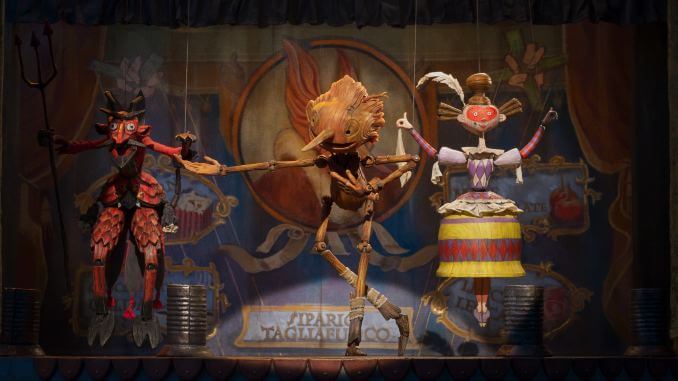A Stop-Motion Marvel, Guillermo del Toro’s Pinocchio Makes Its Fairy Tale Burst with Life

“I want to tell you a story,” says a tiny, six-legged creature. “It’s a story you may think you know, but you don’t.”
Guillermo del Toro has never shied away from infusing the harsh realities of life and death into the journeys of his young protagonists. His fascination with the intersections of childhood innocence and macabre whimsy are what make him the ideal co-director of Netflix’s newest Pinocchio adaptation, a work that marvelously marries the filmmaker’s flair for dark fantasy with the equally strange fairy tale elements of Carlo Collodi’s 1883 The Adventures of Pinocchio. Like all successful marriages, Guillermo del Toro’s Pinocchio brings out the very best of both parties. The stop-motion musical is an artistic triumph that colors Collodi’s cherished storybook characters with humanity and depth to craft a mature tale about rebellion, mortality and the love between a parent and child.
Narrated by Sebastian J. Cricket (an odd but noble raconteur voiced by Ewan McGregor), the film begins years before the marionette has been brought to life, when Geppetto’s (David Bradley) days are brightly lit by the presence of another golden boy, 10-year-old Carlo (Alfie Tempest). Despite the looming threat of fascism, the pair share a picture-perfect life. Carlo is a dutiful son who enjoys spending time at school, church and in the arms of his sweet papa. Geppetto is the adoring father, a parent whose love can only be expressed by way of song: “My son / My son / You are my shining sun… You are everything to me.”
Tender images of companionship and laughter come to a haunting end when Carlo is murdered in a senseless act of war. We fast-forward to Mussolini’s Italy, a gloomy existence where Geppetto spends his days cursing the sky and searching for the warmth of his late son at the bottom of a bottle. On one especially intoxicated night, the woodsman furiously carves a lopsided puppet. When this Frankenstein’s puppet is granted the gift of voice, movement and thought, we embark on a magical adventure where Geppetto must relearn how to be a father and Pinocchio (Gregory Mann), what it means to be alive.
This rendition marks the 22nd film adaptation of the Italian novel, and while it remains true to the grisly nature of Collodi’s original stories, it boldly departs from its dated moral lessons. In The Adventures of Pinocchio (and notable renditions thereafter), Pinnochio’s many escapades are structured as cause-and-effect narratives that serve to caution children against defiant behavior. In Disney’s 1940 animated feature, an evening of fun and relaxation on “Pleasure Island’’ nearly turns the wooden boy into a salt-mining donkey. In the original serial La Storia di un Burattino, delinquent behavior leads him to a gruesome death. These values of compliance and servility are reversed by del Toro’s fascist setting. In his Pinocchio, disobedience is a virtue—not a crime.
-

-

-

-

-

-

-

-

-

-

-

-

-

-

-

-

-

-

-

-

-

-

-

-

-

-

-

-

-

-

-

-

-

-

-

-

-

-

-

-








































